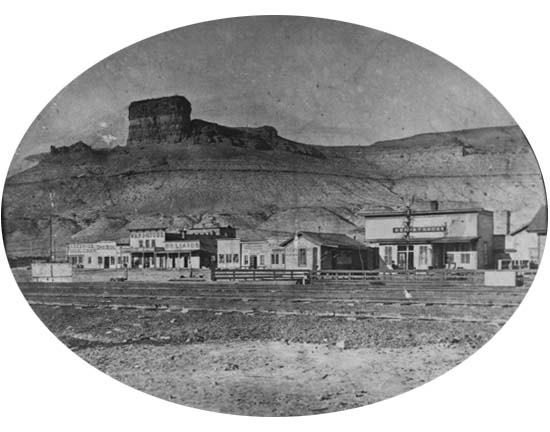
Green River City, 1876
Compare above photo with 1907 on next page.
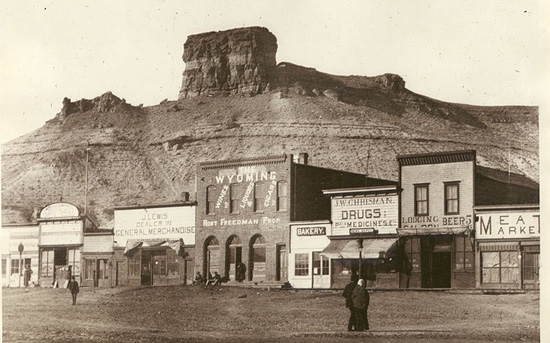
Green River City, approx. 1890
Green River City, now Green River, the third
place of the same name in Wyoming, was founded with the arrival of the
railroad in 1868 when the area was still a part of
Dakota Territory. The first business was that of Jake Field who operated a store, hotel and
rstaurant, as depicted in the next photo. Field, along with H. M. Hook, previously mayor of
Cheyenne, and James Moore, anticipated that the railroad would establish a division point there. Unfortunately,
the three forgot that the railroad was essentially a real estate business. Its
division points were located in towns established by it, such as Cheyenne, Laramie City, and
later Evanston, where the railroad would reap the benefits of lots sales, not third persons. Thus,
while the railroad was passing through, Green River City grew to an estimated 2,000. The population precipitously
dropped to less that 150 after an advertisement appeared in the
Frontier Index:
BRYAN
The
Winter Town, UPRR
Bryan is located on Black's Fork on the line of the
UPRR and will be the terminus of the Railroad for freight
and passengers during the coming winter, and probably until
the connection is made between the UPRR and the Central PRR.
Bryan is the most accessible point to the Sweetwater mines,
and will unquestionably be
The Best Town
for trade between Omaha and Salt Lake City. Large machine
shops and a Round house will be built there immediately.
Now is the time to purchase lots at the low valuation
placed on them by the Railroad company
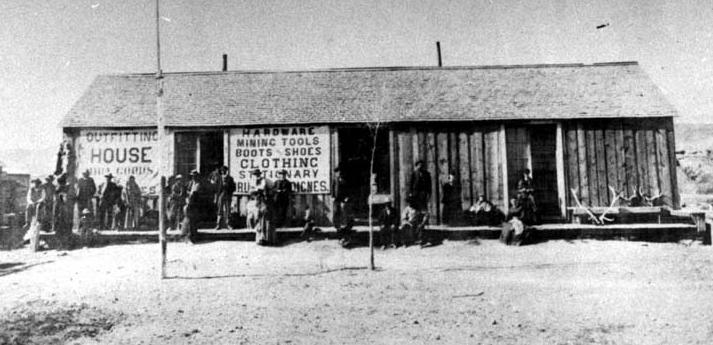
Jake Field's Store, approx. 1871
George A. Crofutt in his 1871 Crofutt's Trans-Continental Guide explained
the effect on Green River City:
This now deserted city was laid out about the first of July, 1868, by H.M.
Hook, first Mayor of Cheyenne City. In this enterprise, James Moore, of
Cheyenne, was interested, and these gentlemen suppose that the terminus
of the road would be at this point during the winter. In September, 1868,
the place had a population of over 2,000, and substantial adobe buildings
were erected, and the town presented a permanent appearance. But the river
was bridged and as the road stretched away to the westward, the town
declined as rapidly as it arose, the people moving on to Bryan, Bear River,
and other points, until there was no one left but those connected with the
stations-in the company's employ. The walls of the old buildings are still
standing, some with the roofs still covering them.
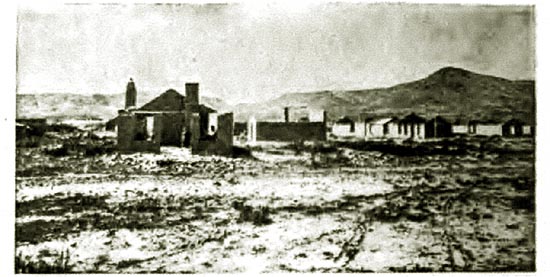
Green River, 1871, photo by E. A. Beaman.
Field arrived from Colorado where he had worked in the express
business in the gold fields. The two Powell Expeditions, which put in from Green
River City, purchased some of its supplies from Field. The first (1869) Powell Expedition
had to await the arrival of equipment. While waiting, the members entertained themselves with liquid refreshment purchased
from Field. As described by John C. "Jack" Sumner (1834-1902), a member of the first expedition from
Middle Park, Colorado:
"We reached Fort Badger [sic], and then on to Green River Station on the Union Pacific
railroads where we camped and awaited orders and in the meantime tried
to drink all the whiskey there was in town. The result was a failure, as
Jake Field persisted in making it faster than we could drink it."
The Company for the first expedition was made up primarily of trappers, hunters, and
army veterans. Powell in his Canyons of the Colorado described the crew:
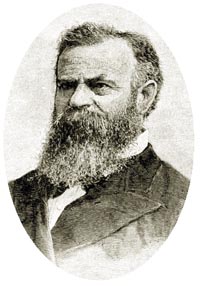 John Wesley Powell, woodcut, 1895
J. C. Sumner and William H. Dunn are my boatmen in the "Emma Dean"; then
follows "Kitty Clyde's Sister," manned by W. H. Powell and G. Y. Bradley;
next, the "No Name," with O. G. Howland, Seneca Howland, and Frank Goodman;
and last comes the "Maid of the Canyon," with W. E. Hawkins and Andrew Hall.
John Wesley Powell, woodcut, 1895
J. C. Sumner and William H. Dunn are my boatmen in the "Emma Dean"; then
follows "Kitty Clyde's Sister," manned by W. H. Powell and G. Y. Bradley;
next, the "No Name," with O. G. Howland, Seneca Howland, and Frank Goodman;
and last comes the "Maid of the Canyon," with W. E. Hawkins and Andrew Hall.
Sumner was a soldier during the late war, and before and since that time
has been a great traveler in the wilds of the Mississippi Valley and the
Rocky Mountains as an amateur hunter. He is a fair-haired, delicate-looking
man, but a veteran in experience, and has performed the feat of crossing
the Rocky Mountains in midwinter on snowshoes. He spent the winter of
1886-87 in Middle Park, Colorado, for the purpose of making some natural
history collections for me, and succeeded in killing three grizzlies,
two mountain lions, and a large number of elk, deer, sheep, wolves,
beavers, and many other animals. When Bayard Taylor traveled through
the parks of Colorado, Sumner was his guide, and he speaks in glowing
terms of Mr. Taylor's genial qualities in camp, but he was mortally
offended when the great traveler requested him to act as doorkeeper at
Breckenridge to receive the admission fee from those who attended his
lectures.
Dunn was a hunter, trapper, and mule-packer in Colorado for many years.
He dresses in buckskin with a dark oleaginous luster, doubtless due to
the fact that he has lived on fat venison and killed many beavers since
he first donned his uniform years ago. His raven hair falls down to his
back, for he has a sublime contempt of shears and razors.
Captain Powell was an officer of artillery during the late war and was
captured on the 22d day of July, 1864, at Atlanta and served a ten months'
term in prison at Charleston, where he was placed with other officers under
fire. He is silent, moody, and sarcastic, though sometimes he enlivens
the camp at night with a song. He is never surprised at anything, his
coolness never deserts him, and he would choke the belching throat of a
volcano if he thought the spitfire meant anything but fun. We call him _
"_Old Shady."
Bradley, a lieutenant during the late war, and since orderly sergeant in
the regular army, was, a few weeks previous to our start, discharged,
by order of the Secretary of War, that he might go on this trip. He is
scrupulously careful, and a little mishap works him into a passion, but
when labor is needed he has a ready hand and powerful arm, and in danger,
rapid judgment and unerring skill. A great difficulty or peril changes the
petulant spirit into a brave, generous soul.
O. G. Howland is a printer by trade, an editor by profession, and a
hunter by choice. When busily employed he usually puts his hat in his
pocket, and his thin hair and long beard stream in the wind, giving him
a wild look, much like that of King Lear in an illustrated copy of
Shakespeare which tumbles around the camp.
Seneca Howland is a quiet, pensive young man, and a great favorite with
all.
Goodman is a stranger to us--a stout, willing Englishman, with florid
face and more florid anticipations of a glorious trip.
Billy Hawkins, the cook, was a soldier in the Union Army during the war,
and when discharged at its close went West, and since then has been
engaged as teamster on the plains or hunter in the mountains. He is
an athlete and a jovial good fellow, who hardly seems to know his own
strength.
Hall is a Scotch boy, nineteen years old, with what seems to us a
"secondhand head," which doubtless came down to him from some knight
who wore it during the Border Wars. It looks a very old head indeed,
with deep-set blue eyes and beaked nose. Young as he is, Hall has had
experience in hunting, trapping, and fighting Indians, and he makes the
most of it, for he can tell a good story, and is never encumbered by
unnecessary scruples in giving to his narratives those embellishments
which help to make a story complete. He is always ready for work or
play and is a good hand at either.
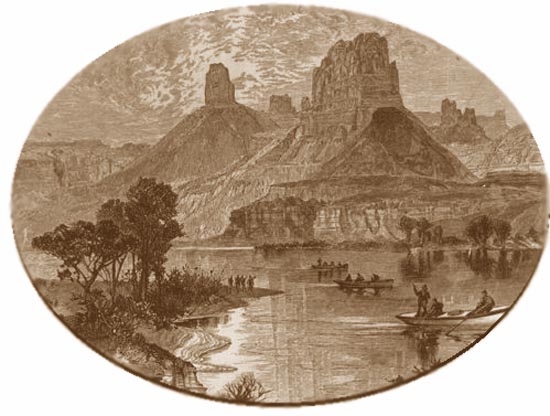
Green RiverStation, "The Start," woodcut from Powell's Canyons of the Colorado, 1895
But, perhaps, the consumption of the
whiskey was as a result of the quality of the coffee. A young Easterner who had been invited to
join the expedition by Powell arrived. The Easterner was particular about the food and
griped for three days. In a 1907 letter to Robert Brewster Stanton, the company's cook,
William Rhodes "Billy" Hawkins described how they got rid of the tenderfoot.
One of the men, Captain W. H. Powell, had a new pair of boots. The coloring from
the leather had impermeated Captain Powell's socks. He requested Hawkins to
boil the socks. Hawkins placed the socks in a small kettle on the stove behind the large coffee
pot, so that it could not be seen. At the noon lunch, Jack Sumner commented that
there was something peculiar about the coffee. Hawkins described the scene:
I took my bowie knife and stuck it in one of the Captain's socks and held it
up over the kettle just back of the coffee. With the reddish brown water
running off, it looked just as though I had taken it out of the coffee
kettle. I yelled "Who in hell put his socks in the coffee?" All said they
had not, except the young man, who did not answer. When I asked him if
he had, he said very politely that he had not, but he was getting up and
leaving at the time. That was the last we ever saw of him.
Later the tenderfoot, wrote Powell telling him that he had a "hard" group about him.
[Writer's note: Robert Brewster Stanton was a railroad and mining engineer who surveyed the
Grand Canyon in 1889-1890.]
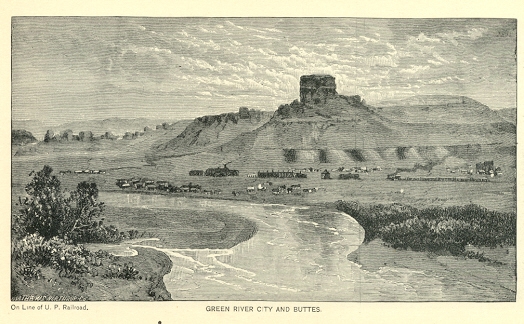
Green River City, 1888
As indicated above, by the time of the Second Powell Expedition, Green River City had
seen better days. Frederick Samuel Dellenbaugh (1853-1935), a member of the second (1871)
Expedition, in his 1902 book "The Romance of the Colorado River," described the 1871 appearance
of the town:
"This Place, when the railway was building, had been for a considerable time the terminus and
a town of respectable proportions had grown up, but with the completion of
the road through this region, the terminus moved on, and now all that was to
be seen of those golden days was a group of adobe walls, roofless and
forlorn. The present 'City' consisted of about thirteen houses, and some of
these were of such complex construction that one hesitates whether to
describe them as houses with canvas roofs, or tents with board sides."
The lodging facilities were hardly better.
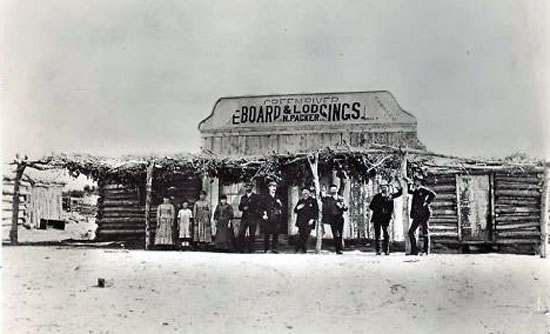
Green River Lodging Facililties, approximately 1871.
Dellenbaugh in his A Canyon Voyage described them:
For sleeping quarters we were isposed in two vacant
wooden shanties about two hundred yards apart and a somewhat greater distance from the
cook-camp. These shanties were mansions left over, like a group of roofless adobe ruins near by, from
the opulent days of a year or wo back when this
place had been the terminus of the line during building operations. Little remained of its shilom grandeur; a section house,
a railway station, a number of canvas-roofed domiciles, Field's "Outfitting Store," and
the aforesaid shanties in which we secured refuge, being about all there was of the place.
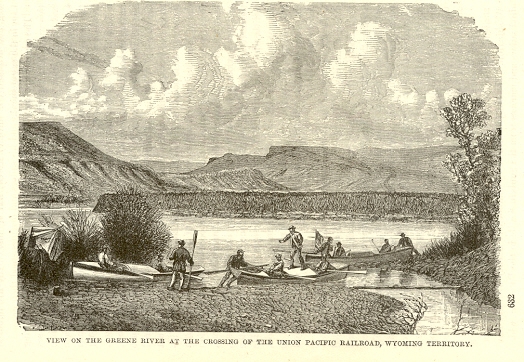
Powell Expedition at Green River, Wyo. Terr., 1871. Engraving based on
photograph attributed E. O. Beaman, see below.
As noted with regard to Sherman, 19th century engravers often
based their work on existing photographs, nor was it uncommon for photographers to take credit for photographs
that they did not personally take. This 1875 engraving was
based on an earlier 1871 photograph of the second Powell Expedition putting in to the Green River near
the Railroad Bridge with, however, some artistic changes.
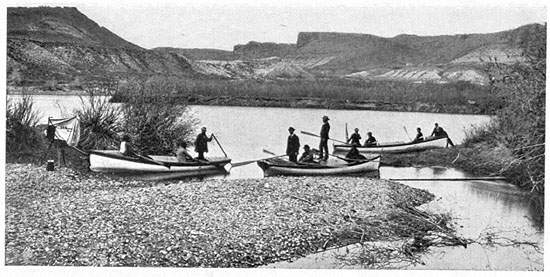
Powell Expedition, May 1871, photo attributed to E. O. Beaman.
Identification as provided by Frederick S. Dellenbaugh,
A Canyon Voyage G. P. Putnam's Son's, 1908, L to R.:
In first boat, the
Canonita, E. O. Beaman (expedition photographer), Andrew Hattan, Walter Clement Powell;
In second boat,
the Emma Dean, Steven Vandiver Jones, John K. Hillers (later assistant
photographer and chief photographer [see text below]), John Wesley Powell,
Frederick S. Dellenbaugh (artist and topographer);
In third boat, the Nellie Powell,
Almon Harris Thompson, John F. Steward, Francis Marion Bishop, and Frank Richardson.
As noted, photogaph is commonly attributed
to expedition photographer E. O. Beaman. See back of stereograph of the scene reproduced below. Beaman, however is, as noted, in one of the
boats and, therefore, could not have taken the particular picture. Missing from the scene is assistant photograper J. Fennemore who did not join the
expedition until March 19 at Pipe Springs.
No one from the expedition is missing from the scene. The mystery is, therefore, who took the picture.
It has been suggested that Beaman set up the scene, prepared the glass plate in the dark box to the left of the
Canonita, placed the plate in the camera, and gave instructions possibly to Jake Field on the timing and removal and replacement of the
lens cap. Beaman would then have removed the glass plate and later developed the picture. In essence, Beaman did all the
heavy lifting and someone else merely removed and replaced the lens cap.
The second expedition was better suited for topographic observations. As previously
observed, the first expedition included many Colorado trappers. Of the original ten, only six emerged at the far end.
Hawkins later complained that he and Sumner were stiffed by Powell. According to Hawkins,
Powell promised to pay Hawkins $1.50 a day, reimburse him $960.00 for animals, and pay him $2.50 each for
36 traps which had cost Hawkins $3.00 each. At the end of the journey, Powell gave Hawkins $60.00, not even enough
to reimburse for the traps, let alone the animals or the $1.50 a day for the almost 100 days of the expedition.
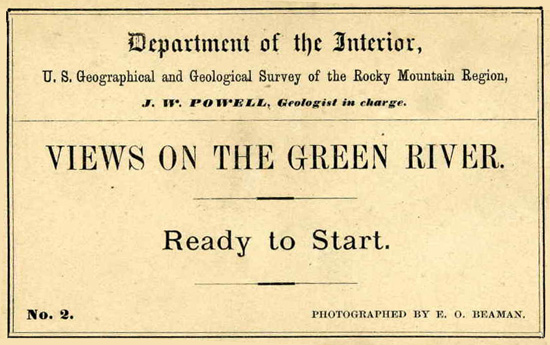 Back of stereograph. Start of Powell Expedition.
Back of stereograph. Start of Powell Expedition.
The two Powell Expeditions were the
first to explore the Grand Canyon of the Colorado, a subject beyond the scope of this
website. However, Powell correctly deduced that the Colorado River is really an extension of
Wyoming's Green River, rather than Colorado's "Grand River." In addition to
exploring the Grand Canyon, the expedition produced three of the great western photographers: Beaman
who took the photographs for the first part of the expedition, Fennemore who took the photographs for the
middle part, and finally Hillers who did the final part. As noted above,
Beaman started out as the chief photographer until, as a result of a dispute with
Powell, he was fired. Fennemore, formerly the assistant, then became the chief photographer and
trained Hillers as an assistant. Hillers had originally been employed on the
expedition as an oarsman. Fennemore, himself, had been trained under the great Mormon photographer
C. R. Savage, see Sherman. When Fennemore became ill on the
expedition, Hillers became the chief photographer. Hillers remained with the United States Geologic Survey
until 1919.
Green River City found its salvation when the Black's Fork dried up and there was no water for the
locomotives or the roundhouse operations. The railroad, thus, had to put its tail between its legs
and crawl back to Green River City.
Next page Green River continued.
|